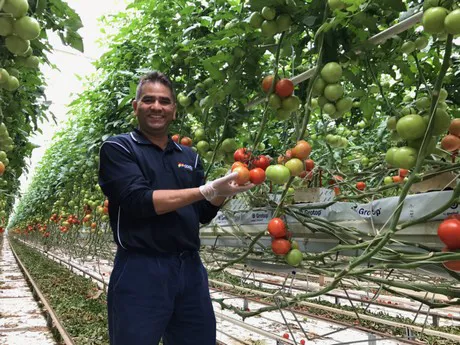Keshav Timalsena is a senior grower at the 30 hectare greenhouses operations of Costa Group in New South Wales. Originating from Nepal, he started his career in New Zealand, where he worked for a large 20 hectare greenhouse operation between 1995 and 2007. When he moved to Australia, he became a supervising senior grower at the tomato greenhouses of Costa in Guyra, looking after 10 hectare himself and helping two other growers oversee the other two greenhouses of 10 hectare each.

Keshav Timalsena at the 10 hectare greenhouse he manages for the Costa Group in Guyra.
Being a commercial grower, Timalsena is confronted with daily challenges that almost any glasshouse grower has to overcome in order to produce as efficient as possible, maximizing yields and lowering the pest pressure. For this reason, it was no surprise that he wanted to examine the potential of semi closed greenhouse growing when he was selected as one of the Nuffield Scholars in 2014.
But before he could do so, he joined an eight week Global Focus Program of the Nuffield Scholars to study challenges and innovations in global agriculture. Together with another 8 scholars, the group visited all kinds of producers in various countries like Brazil, New Zealand, Holland, Belgium, Mexico, The United States and The United Kingdom. From plastic greenhouses in Mexico to large scale sugar cane, kettle feed, wheat, cotton, poultry and diary farms across South America; within eight weeks the group got acquainted with innovative farming and the challenges all across the world.
As part of his overseas travel program, Timalsena also concluded several individual visits to greenhouse growers and innovators all over the world to talk with them about the potential of semi closed greenhouse growing. "I spoke with many greenhouse growers, researchers and greenhouse builders about how semi closed greenhouse growing can help to take greenhouse production to the next level, carefully examining the various regions and situations", Timalsena said.
In The Netherlands he visited the 10 hectare semi closed greenhouse of Red Star. This was the first Dutch greenhouse grower that started with the KUBO-built and Casey Houweling' patented Ultra-Clima greenhouse in the Netherlands. The design enhances a higher CO2 level with a higher yielding crop and 40% less energy input as a result. "I also visited the VB Climate ActivAir semi-closed greenhouse of Looije Tomatoes in Burgerveen and the semi-closed greenhouses of Prominent."
"As well as this I went to see normal greenhouses in Holland and Belgium to learn more about the potential of the structures in an optimal setting. The Dutch growers really know how to run a greenhouse at its full potential, and even our high tech operations in Australia can learn from this. This learned me that in a situation like The Netherlands, a semi closed structure does not always make sense, since you can achieve already great results with a standard structure and the moderate temperatures do not need any cooling throughout the year."
Yet, Keshav also visited growers in countries and climates where it nowadays seems impossible to grow without a semi closed greenhouse. He visited Casey Houwling in California. Houweling is the founding father of KUBO's Ultra-Clima semi closed greenhouse concept. "Houweling once lost his entire tomato crop due to a devastating whitefly plague, but ever since he converted his operations into sem-closed structures, he keeps every pest outside and increased his growth due to higher CO2 levels."
As well as this Timalsena visited the greenhouse of SunSelect in Tehachapi, California, where they grow bell peppers and tomatoes year round in an Ultra-Clima too. "California, depending on the area altitude, can has a very dry climate and it often can get very hot. A semi closed therefore makes much sense, because you will not only lower the pest pressure and use of chemicals, but you will create a very consistent and favorable climate to grow a quality crop year round. Also growers I visited in the South of France , where it can also get pretty hot, realized this and therefore semi closed has become the standard for them too.
Coming back home, Timalsena furthermore visited several growers in Australia and New Zealand to discuss the potential of semi closed growing in their region. "I was in New Zealand for two weeks and visited a couple of growers to learn more about their challenges and climates. We concluded that a semi closed structure not always would made sense, especially when you are growing on a high altitude with low night temperatures. Yet, growers in the Oakland region, are dealing with high humidity levels, and a semi closed greenhouse for them could help them help create a dryer and more active climate to deal with diseases like powdery mildew."
Timalsena also discussed the built of a semi closed structure at the farm of his employer. "While we recently expanded our operations with a 46 million dollar greenhouse that was not semi closed, but technically still very advanced, we might consider a semi closed structure for a next expansion. I absolutely see clear benefits of this, because it will help us to gain our CO2 with consistent levels, increase our production with uniform growth, reduce our pest pressure and create a stable climate, from corner to corner.
The entire report of Keshav Timalsena's Nuffield Scholar Semi-Closed Greenhouse study is available for download by clicking here (PDF).
